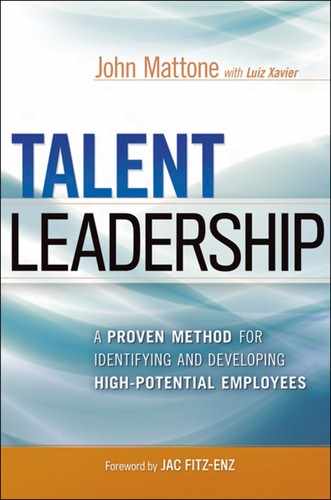CHAPTER 3
The Leadership Wheel of Success™: The Outer Core
Leadership Capability (i.e., can-do), Commitment (i.e., will-do), and Alignment (i.e., must-do) are the Leading Indicators that predict operating success in your organization. If your leaders possess and execute all three leading indicators, your organization will flourish because your leaders, individual contributors, and teams will flourish. Leaders—great leaders—continuously commit to strengthening their own can-do, will-do, and must-do. However, it is also critical to recognize the irrefutable connection that exists between when leaders actually make the free choice to commit to continuous improvement and the resulting impact this free choice decision has on the people who report to them. Ultimately, under the umbrella of their own ever improving Capability, great leaders create a powerful, engaging culture in which their people and teams make the free choice to commit to continuous improvement. This is how great leaders truly unleash their talent. This is the essence of talent leadership.
Unfortunately, however, there are many misconceptions about what leadership is or is not. One of the most significant misconceptions is that every great leader is born to lead. In fact, some leaders—the minority—were born with the right DNA, makeup, and characteristics. Because of the gifts bestowed on them, they demonstrate a clear predisposition to becoming great leaders notwithstanding the effects of family and cultural factors. Some leaders simply have “the right stuff” and have always had it. That said, the vast majority of great leaders—over 95 percent—have become great leaders through personal choice, The evidence of great leadership is the evidence of a leader who has made a conscious decision to execute the can-do, will-do, and must-do and commit to never-ending improvement. This is the notion of calibration-development-recalibration that we see present in great organizations (stealth organizations) who develop great leaders (stealth leaders).
As indicated in Chapter 3, any efficient and effective Stealth Fighter needs a compelling target to propel itself toward. All great leaders need a very clear picture in their minds as to what Capability, Commitment, and Alignment constitute. Every great leader needs to know exactly what that picture looks like in his or her particular organization. This notion, that the definition of leading indicators for leaders is different for every leader and organization, led to the explosion of competency modeling work primarily in the 1980s and early 1990s. Every organization was creating their own Stealth targets and, of course, this led to the explosion of consulting and research firms who took advantage of real market needs to help these organizations research and define leadership success in their own “unique” organization for their own “unique” leaders.
The result? We have learned that the definition of leadership success—the leadership success target comprised of leadership can-do, will-do, and must-do—is really not all that unique to a particular leader or organization. In the process, through years of research, we have gained tremendous intelligence about leadership success and the competencies that define success. The early leadership competency work done by David McLeland and McBer and Company, as well as the more recent work of the Center for Creative Leadership, John Kotter, Lominger, Executive Development Associates, JMP, and hundreds of other notable researchers and leading thinkers, has added not only unique perspective but also a corroborative perspective that there is value in creating a universal target of leadership success.
Exhibit 3.1 presents the Leadership Wheel of Success™, a universal target of leadership success that is not particularly unique in some respects but truly unique in others. The outer core consists of nine strategic leadership competencies and skills:
1. Critical thinking
2. Decision making
3. Strategic thinking
4. Emotional leadership
5. Communication skills
6. Talent leadership
8. Change leadership
9. Drive for Results
Exhibit 3.1: The Leadership Wheel of Success™

The inner core consists of intrapersonal and interpersonal elements that strongly impact the leader’s development of the nine leadership competencies. There is a predictive relationship between the inner core and outer core. A leader who has a strong inner core has the capability to grow, develop, and mature in the development and evidence of the competencies and skills that comprise the outer core.
The predictive connections are as shown in Exhibit 3.2.
The Leadership Wheel of Success™ is unique in that no other current leadership competencies models exist that describe and detail these predictive relationships and the power of the inner/outer-core connection in driving superior leadership.
The Leadership Wheel of Success™ clearly has implications for how organizations can best calibrate and recalibrate a leader’s inner and outer cores (i.e., 360s, performance reviews, and simulation-based assessments to calibrate the outer core; personality and cognitive assessments to calibrate the inner core), as well as deploy effective executive coaching (more on this later). Measurement and remeasurement of a leader’s outer and inner core should provide a very clear picture of a leader’s current and future (i.e., potential) can-do, will-do, and must-do, leading to more accurate and effective decision making, including who needs to be coached—when, where, why, and how—as well as driving more accurate and effective high-potential identification and succession planning.
Exhibit 3.2: The Predictive Connections

The Outer-Core Leadership Competencies
Critical Thinking
The word thinking can describe any number of mental activities (Exhibit 3.3).
Exhibit 3.3: Critical Thinking

Much of a leader’s natural thinking, when left unchecked, is biased, distorted, partial, uninformed, or downright prejudiced. Yet the effectiveness of leaders depends precisely on the quality of their thoughts. Critical thinking is that mode of thinking, about any given subject, in which thinkers improve the quality of their thinking by skillfully taking charge of its very structures and by imposing intellectual standards on them. However, effective critical thinking involves consideration of the full range of possibilities to a problem, including emotional, cognitive, intellectual, and psychological factors.
Shallow thinking is costly, in terms of both money and quality of life. Successful leaders are able to apply what they know to the challenges of their work. All organizations today are not interested in hiring and retaining walking encyclopedias; rather, they require leaders who are independent decision makers and problem solvers and who can model this behavior to their people and teams.
A strong critical thinker executes the following abilities (RED):
• Recognizes assumptions
• Evaluates arguments
• Draws conclusions
(We’ll see more on this in Chapter 6.) However, Pearson’s Watson-Glaser II Critical Thinking Assessment is the most widely used assessment of critical thinking in business today. It is the gold standard for measuring critical thinking ability and decision making in high-potential professionals, new managers, experienced managers, and emerging leaders. Significant research by Pearson and other independent researchers shows a strong relationship between higher scores on the Watson-Glaser and higher performance, greater upward potential, more effective problem solving and decision making, and stronger strategic thinking and planning skills. In two of Executive Development Associates’ most recent executive trends surveys—in which hundreds of senior human resource executives from across the globe are surveyed—has identified critical thinking as the number one skill of increasing importance for leaders and future leaders today; however, according to these human resource executives, only 1 to 28 percent are seen as “excellent” critical thinkers.
Based on the authoritative research that clearly connects a leader’s and emerging leader’s critical thinking capability with their achieving higher level performance and realizing their potential, combined with the realization that business will be more complex tomorrow than it is today, this element is perhaps the most pivotal leadership element for leaders, future leaders, and organizations as they strive to become the best they can be (think Stealth Leadership). Simply put, a leader’s ability to make sound decisions, problem-solve, plan, and implement, as well as execute sound strategic thinking, is all based on superior critical thinking (i.e., RED).
• Recognize Assumptions: Assumptions are statements that are implied to be true in the absence of proof. Identifying assumptions helps in the discovery of information gaps and enriches views of issues. Assumptions can be unstated or directly stated. The ability to recognize assumptions in presentations, strategies, plans, and ideas is a key element in critical thinking.
• Evaluate Arguments: Arguments are assertions that are intended to persuade someone to believe or act in a certain way. Evaluating arguments is the ability to analyze such assertions objectively and accurately. Analyzing arguments helps in determining a confirmation bias—the tendency to look for and agree with information that confirms prior beliefs. Emotion plays a key role in evaluating arguments because high emotion clouds objectivity.
• Draw Conclusions: This involves arriving at conclusions that logically follow from the available evidence. It involves evaluating all relevant information before drawing a conclusion, judging the plausibility of different conclusions, selecting the most appropriate conclusion, and avoiding over-generalizing beyond the evidence.
Decision Making
Decision making is one of the most important tasks that leaders of all levels must face (Exhibit 3.4). This becomes particularly challenging when a leader has incomplete or contradictory information and when the time is short and the impact of the decision is high. Possessing the ability to make wise decisions quickly in the context of the organization’s culture is a crucial skill. The following Seven Elements of Optimal Decision Making detail the specific behaviors that define great decision making:
Exhibit 3.4: Decision Making
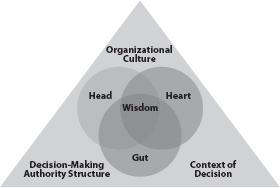
1. Using Your Head to Make Rational Decisions: Collecting, analyzing, and utilizing accurate data from multiple relevant sources and objectively assessing the impact of the alternative decisions
2. Using Your Heart by Listening to Yourself and Others: Making decisions that will have wide acceptance and that are aligned with the core values of the organization.
3. Using Your Gut by Trusting Your Instincts: Having a trustworthy gut that instinctively knows the right course of action and being able to effectively remove obstacles that might impede its implementation
4. Making Wise Decisions by Integrating Your Head, Heart, and Gut: Having clear access to your head, heart, and gut so that the decision made will stand the test of scrutiny and time
5. Understanding the Organizational Culture: Knowing, respecting, and, in most cases, honoring the organization’s expectations regarding how decisions are best made and executed
6. Honoring the Organization’s Decision-Making Authority Structure: Fully understanding and utilizing the decision-making lines of authority as well as delegating decision making where appropriate and effective
7. Factoring in the Context of the Decision: Effectively balancing the situation’s many factors—for example, time urgency, risk level, and strategic priorities—into the final decision
Strategic Thinking
Leaders at all levels need to fully understand the business of the organization and be able to think and act strategically on an ongoing basis (Exhibit 3.5). Organizational environments change rapidly; talented employees have many options for where and how they work, and customers can choose where to obtain products and services. When leaders excel in the Eleven Competency Elements of Knowing the Business, they think and act strategically and enable their organizations to reach the highest levels of performance, effectiveness, and efficiency.
This competency contains eleven elements, divided as follows:
Know the Business: The Business Environment (three elements)
1. Knowing the Industry: Knowing the key environmental factors, industry trends, and being professionally networked
Exhibit 3.5: Strategic Thinking

2. Knowing the Marketplace: Knowing the market, the competition, and your organization’s strengths and weaknesses
3. Knowing the Customers: Knowing the needs and expectations within customer segments and classes and effectively responding to current and future customer requirements
Know the Business: The Organization (three elements)
1. Knowing the Structure, Systems, and People: Fully understanding how all aspects of the organization work and fit together, being able to successfully navigate through its systems, and designing an effective organizational infrastructure to support the work
2. Knowing the Products, Services, and Technologies: Maintaining a current and future view of what the organization offers its customers and the technology that supports this, and making deliberate and wise changes to these as needed
3. Knowing the Finances: Understanding and using a variety of financial tools as management tools and using organizational resources effectively and efficiently
Think and Act Strategically (five elements)
1. Creating a Compelling Vision: Developing a values-based, inspiring, and realistic vision that engages others to use it as a guidepost
2. Defining a Viable Mission: Clarifying the business you are in based on your unit’s or organization’s vision, strengths, limitations, and the desires of your present and future customer base
3. Developing Synergistic Strategies: Crafting a set of strategies that are integrated, leveraged off one another, and that enable those who work for you to achieve the mission and make effective decisions
4. Creating Quantifiable Goals: Setting realistic and quantifiable goals that allow people to stretch their capabilities and achieve the strategies
5. Designing Successful Tactics: Designing actions and activities for accomplishing each goal, utilizing these activities to achieve more than one goal when possible, and developing effective plans for their implementation
Emotional Leadership/Intelligence
Emotional intelligence is a combination of competencies (Exhibit 3.6). These skills contribute to leaders’ ability to manage and monitor their own emotions, correctly gauge the emotional state of others, and effectively influence others. Each area has its own set of behavioral attributes:
• Self-awareness is the ability to recognize a feeling as it happens, to be introspective, and to exhibit strong self-confidence. It is the keystone of emotional intelligence.
• Self-management or self-regulation is the ability to keep disruptive emotions and impulses in check (self-control), maintain standards of honesty and integrity (trustworthiness), take responsibility for one’s performance (conscientiousness), handle change (adaptability), and be comfortable with novel ideas and approaches (innovation).
• Motivation is the emotional tendency guiding or facilitating the attainment of goals. It consists of achievement drive (meeting a standard of excellence), commitment (alignment of goals with the group or organization), initiative (acting on opportunities), and optimism (persistence in reaching goals despite setbacks).
• Empathy is the understanding of others by being aware of their needs, perspectives, feelings, and concerns and sensing the developmental needs of others.
Exhibit 3.6: Emotional Leadership/Intelligence

• Social skills are fundamental to emotional intelligence. They include the ability to induce desirable responses in others by using effective diplomacy to persuade (influence); listen openly and send convincing messages (communicate); inspire and guide groups and individuals (leadership); nurture instrumental relationships (building bonds); work with others toward a shared goal (collaboration, cooperation); and create group synergy in pursuing collective goals.
Communication Skills
Being an excellent communicator is an important skill for employees at all organizational levels (Exhibit 3.7). For leaders, it is an essential skill. Leaders must communicate constantly—in person, via telephone, in writing, and through electronic media. Leaders must also communicate effectively with a variety of people: employees at all levels, customers, vendors, suppliers, bosses, and, depending on their role, representatives of regulatory agencies, politicians, and members of the media.
Exhibit 3.7: Communication Skills
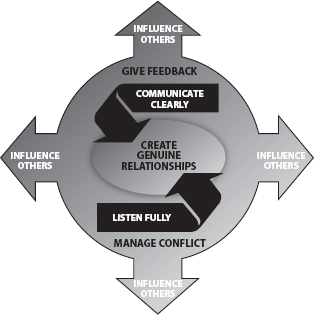
• Creating Genuine Relationships: Being warm, open, and approachable; treating others with respect; and being regarded as a person of integrity
• Communicating Clearly: Communicating accurate information in a clear and timely way, using constructive formal and informal channels to do so
• Listening Fully: Giving your full attention to others when they are communicating and accurately processing what is said with a minimum of personal bias
• Giving Effective Feedback: Providing honest, clear, and respectful feedback to others in the organization, voluntarily soliciting feedback yourself, and being open to what is said
• Managing Conflict Constructively: Responding to conflict, both when you are directly involved and when you are not, with a problem-solving, non-blaming approach that produces successful outcomes
• Influencing Others: Being able to effectively and constructively influence others in a nonmanipulative way
Talent Leadership
In Chapters 1 and 2, we discussed the four D’s of Talent Leadership and their critical importance in successfully propelling the company toward its future desired state. (See the Stealth Fighter Model in Chapter 2.)
In today’s tough economy, leaders at all levels are facing enormous challenges when it comes to effective talent leadership. All leaders are being asked to do more with less. All leaders are worried that their top talent will be lured away by the competition as the economy improves. And all leaders are being asked to attract, select, onboard, engage, motivate, and retain employees. More than ever, accountability for executing superior talent management practices resides with leaders—not with Human Resources.
And, to be successful, leaders must understand and embrace their roles as talent leaders, in executing the four D’s of talent leadership:
• Deployment: How to select and on-board talent
• Diagnosic: How to monitor individual and team engagement levels
• Development: How to build winning relationships, how to build a cohesive team, and how to coach
• Demarcation: How to give feedback, how to reward individual and team performance
Team Leadership
Teams are the foundation of all contemporary organizations: work teams, cross-functional teams, matrix teams, task forces, management teams, and more (Exhibit 3.8). All teams must have one or more common goals for team members and some degree of interdependence between and among members for achieving these goals. To be high performing, a team must have more than common goals and the necessary degree of interdependence required by the work itself. They need to have leadership, a vision, the right talent, an appropriate architecture or structure, effective processes, and a team-oriented culture—all to create quality products and services. Without this last element, teams may think they are high performing, but, in essence, they are only performing for themselves. Providing quality customer products and services must always be the highest priority.
Exhibit 3.8: Team Leadership
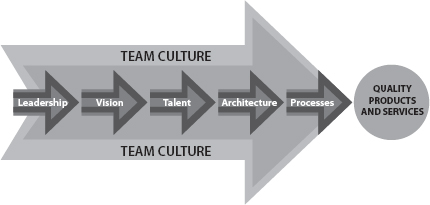
1. Providing Team Leadership: Showing versatility in your leadership style, at the same time providing a consistent sense of direction for the team and using your power and authority justly and wisely
2. Creating a Team Vision: Developing a collaborative and inspiring team-based vision that is aligned with the mission, strategy goals, and tactics
3. Attracting and Developing Team Talent: Being the place where talented employees want to work and stay
4. Designing a Team Architecture: Structuring all aspects of the work, from the organizational structure to the actual workflow, so that employees can do their best work without confusion or unnecessary obstacles
5. Building a Team Culture: Creating by word and action a culture where individuals feel valued, their strengths are leveraged, and team members support one another’s development
6. Assuring Quality Products and Services: Making sure that everyone keeps the customer at the forefront, including establishing excellent relationships with vendors and suppliers
To accomplish the highest level of results in organization and teams, leaders need to pay attention not only to the end result, but also to six other areas along the way. When leaders pay close attention to these six areas, they get excellent results and get them repeatedly.
1. Setting Overall Direction and Establishing Common Goals: Aligning work with vision and strategy, while having effective goals, performance standards, and resource allocation
2. Creating Workable Plans: Developing clear, realistic plans; making timely decisions; defining deliverables; and being flexible
3. Assigning Tasks Effectively: Delegating to the right people with the appropriate skill sets in an equitable way, as well as empowering others
4. Expecting, Measuring, and Rewarding High Performance: Creating ongoing accountability, development opportunities, and feedback; aligning the reward system with performance expectations; and modeling exemplary performance
5. Providing Ongoing Stewardship: Knowing and monitoring the entire work process and the human interactions, but without micromanaging, to address issues effectively when they arise
6. Evaluating Results and Utilizing What You Learn from the Evaluation: Evaluating end results using multiple measures and doing rigorous post hoc debriefings to integrate this information into future work
Change Leadership
Taking charge of change has become a way of life in organizations. Being able to manage change, at least to some degree, is something most leaders can do. However, to take charge of change requires more mastery.
Part 1: Design the Change
To understand how to do this requires an understanding of how to manage the three major activities involved with change: (1) designing what the future of the change should look like; (2) assessing the current situation in relation to the desired change; and (3) planning and managing the transition from the current situation to the desired future.
Fifteen or more years ago, most so-called change leaders first assessed the current situation, then designed the future. Often, however, this strategy created only small improvements because it was only based on what-is and did not take into account the desired future state. Today, change leaders first design the future in general terms, defining what they want to see in the future. Then they go back, assess the current situation, and design the future in more specific terms. A thoughtful and thought-through transition is critical; otherwise, there’s no road map for moving from the present to the future. In addition, the ongoing business must be managed and led at the same time as the change. This can put a great deal of pressure on leaders to execute the required change and manage business as well.
Part 2: Develop a Change Strategy
Here, the change strategy formula is very helpful:
D = demand and desire for change and the dissatisfaction with the current situation. A high D provides the motivation for the change.
V = the vision for the change, stated in a clear, compelling way that is well and widely communicated. Without a strong V, there is neither a shared direction nor a belief that those in charge of the change know where it’s going.
P = the plan and process for reaching the change. This is similar to the transition already described, but it also includes concrete information about what the organization will look like after the change occurs. Thus, P has some elements in it from the designed future.
R = resistance to the change. Almost every change effort incurs resistance. With too much R, either the change effort will never materialize or the change will occur but implementation will be very difficult. With no obvious resistance, a leader should begin to wonder, “Why? Where is the resistance? Are we really doing something different enough?”
C = the change you want to occur. Although it may sound like the designed future mentioned earlier, the C is really more about the main goals of the change effort rather than the details of the design.
The change strategy formula says this: For change to occur, there must be sufficient D (demand, desire, dissatisfaction), sufficient V (a clear and compelling vision for the change), sufficient P (plan and process for how to get to the end results), and all three (D, V, and P) must be greater than R (resistance to the change for the change to occur). These are the elements of the change that leaders must lead. Notice that there is a multiplication sign between the first three elements (D, V, and P) rather than an addition sign. This is because if any of these elements is 0 (zero), no change will occur, even if the other two elements are strong.
Part 3: Take Charge of Change
To take charge of change, leaders must take the first two areas just described: Design the change and develop a change strategy while still leading and managing the ongoing business. Now we add one more element. Leaders must learn how to be a change-champion. In Exhibit 3.9, you can see all these elements. Notice that designing the future includes anchoring or institutionalizing the change, and resistance must also be addressed. Resistance emerges during the time when the current situation is being assessed and people are just learning about the need for change. This is the time to increase the desire and demand for the change. Resistance will also emerge during the transition period. Leaders need to anticipate and respond effectively to the inevitable resistance that occurs during these three periods. The following elements of taking charge of change provide more detail:
1. Understanding the Current Situation: Being able to accurately assess the need for change and build support for it
2. Creating the Change Vision: Using multiple and effective means to develop and communicate the change vision
3. Managing the Transition: Developing and implementing an appropriately rigorous change plan and process
4. Reducing Resistance to Change: Accurately identifying and effectively responding to the resistance
5. Designing the Future of the Change and Anchoring the Change: Constructing a well-designed change that becomes integrated into the daily life of the organization
Exhibit 3.9: Change Leadership
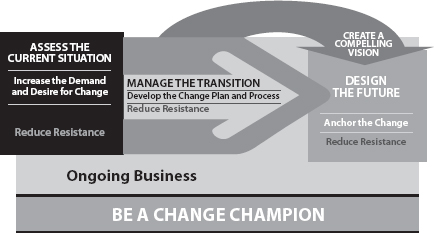
Drive for Results
To accomplish the highest level of results in organizations and teams, leaders need to pay attention not only to the end result, but also to six other areas along the way (Exhibit 3.10). When leaders pay close attention to these six areas, they get excellent results and get them repeatedly.
1. Setting Overall Direction and Establishing Common Goals: Aligning work with vision and strategy, while also having effective goals, performance standards, and resource allocation
2. Creating Workable Plans: Developing clear, realistic plans; making timely decisions; defining deliverables; and being flexible
3. Assigning Tasks Effectively: Delegating to the right people with the appropriate skill sets in an equitable way, as well as empowering others
4. Expecting, Measuring, and Rewarding High Performance: Creating ongoing accountability, development opportunities, and feedback; aligning the reward system with performance expectations; and modeling exemplary performance
Exhibit 3.10: Drive for Results

5. Providing Ongoing Stewardship: Knowing and monitoring the entire work process and the human interactions, but without micromanaging, so you can address issues effectively when they arise
6. Evaluating Results and Utilizing What You Learn from the Evaluation: Evaluating end results using multiple measures and doing rigorous post hoc debriefings, so you can integrate this information into future work
Calibrating the Outer Core: The Strategic-Tactical Leadership Index-360™ (STLI-360™)
Multirater surveys (or 360-degree surveys) are among the most widely used leadership assessments today. Their popularity has increased dramatically as the growth of the Internet has made implementation easier, cheaper, and faster. JohnMattonePartners’ (JMP’s) STLI-360™ is one of the most widely respected leadership multirater assessments in existence today, with a growing database and applicability across multiple levels of leadership.
The STLI-360™ was developed by me based on exhaustive reviews of competency research conducted by Lominger, John Kotter, the Center for Creative Research, and Executive Development Associates. The STLI-360™ is based on the Leadership Wheel of Success™, which uniquely identifies both the inner and outer core attributes, such as self-image, beliefs, values, and character, that impact leader thoughts and behaviors, and then the evidence of skills and competencies. The STLI-360™ is a valid measure of the outer core tactical skills and strategic competencies that account for leadership success.
Why Use the STLI-360™?
In a knowledge-based economy, it is increasingly important for organizations to understand the competencies required for leadership success and then develop those critical competencies on an ongoing basis. Accurate assessment data is vital to being able to do that well.
